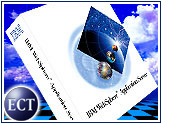
WebSphere Commerce, IBM’s e-business software, got more than a fresh coat of paint and minor tweaks in a recent upgrade to version 5.6.
In fact, Steve Gatto, marketing manager for IBM WebSphere Commerce, told the E-Commerce Times that enough improvements have been made to the application that it should have been bumped up to version 6.0 by now. However, the company has slowed down the product’s versioning to match other services and products that complement it.
Despite the non-glitzy version numbering, WebSphere Commerce 5.6 still is a major advance, according to Gatto. “It’s a great addition to the portfolio in general,” he said.
Key Upgrades
However, WebSphere 5.6 does not contain any new features that significantly differentiate it from previous versions. Instead, IBM focused on making strategic enhancements in line with customer requests and the company’s own plans to align the application with other on-demand strategies.
According to Gatto, the new release reduces total cost of ownership, improves ROI, enhances business users’ experience and is an optimized solution for small and medium businesses.
“There’s a group of capabilities that we released in a prior version that we’re continuing to enhance,” he said.
Key improvements include streamlined processes for segmenting a master catalog and redesigned promotion and campaign management capabilities. The new version also includes a feature that allows manufacturers and distributors to integrate their operations more efficiently with a partner network.
WebSphere Commerce is built on open standards and supports a variety of operating systems. Because its open architecture is based on a Java programming model, most developers can use it to add or customize features. The infrastructure is built on IBM software products, including WebSphere Application Server and DB2 Universal Database.
Size Doesn’t Matter
Forrester analyst Andrew Bartels told the E-Commerce Times that with WebSphere, IBM has done a good job of making an application that appeals to companies of different sizes.
WebSphere Commerce-Express is designed for small and mid-size businesses and costs US$20,000 per processor. That fee includes licenses for development, staging and production.
Meanwhile, WebSphere Commerce Professional Edition is aimed at business-to-business (B2B) and business-to-consumer (B2C) online operations. It costs $80,000 per processor. At the high end, the $125,000-per-processor Business Edition is geared toward large, high-volume B2B and advanced B2C e-commerce.
“IBM continues to have attractive introductory prices for SMBs with this,” Bartels said. “The pricing for the Express version will be major for bringing in new business.”
Beefed Up
Bartels also noted that of the enhancements, some are more compelling than others. In particular, he said, the business context engine enables better personalization.
Personalization is important because a user can define interactions based on the rules and authorities of a particular business buyer. Particularly in the B2B market, this is crucial, Bartels noted, because it defines the role of an agent, or contact. If an agent at another company has the power to purchase only certain types of items, the application will be able to identify that.
“You find personalization in other applications,” Bartels said, “but what IBM has tried to do is take it beyond where it is now and tie it to roles and responsibility levels within an organization.”
He added that IBM’s competitors have been moving in this direction as well, but Big Blue is staying ahead in the personalization race so far and is executing its strategy better than its rivals.
Initial Success
Although the new version has been available to customers for only a limited time, IBM claims feedback has been positive. One IBM partner, SCS, already has noticed several changes to operations as a result of using version 5.6.
“There’s a tremendous evolution in the product,” SCS vice president Darrin Nelson told the E-Commerce Times. “From the development side, there’s a significant decrease in time-to-market.”
He noted that in terms of site development time, it takes half the time to start the SCS test server and 85 percent less time to recycle it than with older versions. Also, compared with the previous version of WebSphere Commerce, fewer resources are required: Nelson estimates resource requirements have dropped by 30 percent.
Also an improvement is 5.6’s set of business tools, called the Commerce Accelerator. Nelson noted that it provides for more productive management, especially in the discounts area.
“We think that IBM already had a strong product,” he said. “And now they’ve made it better.”























































Social Media
See all Social Media